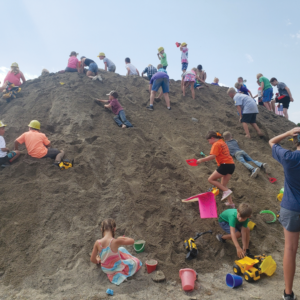Dig It Days, which was held the last two days of MontanaFair, had the best turnout ever in its four-year history. A long line of children with parents and grandparents wound far out into the middle of the fairgrounds as they waited for gates to open. As they began to make their way past the entry table to get t-shirts and “hard hats,” one little boy, looked up and proudly proclaimed, “I am going to be a worker!”
He got it.
To introduce youngsters and oldsters, alike, to the construction industry is part of the purpose of Dig It Days, but more important it’s about having fun – and every kid got that, as did the adults. One grandfatherly looking man, as he walked out said, “It was wonderful to see the smiles on their faces.”
With a record number of sponsors – 34 of them – Dig It Days had more amazing displays and things for kids to do than ever before. It is the sponsors – the equipment dealers, contractors, and other related businesses that bring the equipment, staff the booths, and orchestrate activities, as well as fund all the costs, so that kids can climb on, pretend to operate, and learn about all kinds of big machines. They also get to operate the backhoes and excavators, and dig in Sand Mountain for the sheer joy of it, as well as hope to win prizes. Kids had an opportunity to operate metal detectors to find coins, and inspect the county sheriff’s helicopter, and mix up some concrete to make their own stepping stone. It was all hands on.
As the construction industry struggles with labor shortages, an event like Dig It Days brings back a connection with the public, which seems to have been lost over the recent past, about the importance of the industry and the amazing innovations that have evolved that make it a challenging, cutting edge and rewarding career option. It is that connection that industry leaders are trying to re-establish, not just with the young but with their parents and grandparents as well. Funds generated from Dig It Days go into a scholarship fund administered by the Montana Contractors Association.
Johnathan McNiven, owner of Yellowstone County News and President of Yellowstone Family Foundation which organizes the event, said he was blown away by the increase in sponsors this year. And, as he sought out participation, he encountered others who were enthusiastic and promised they would be there next year, promising continued growth.
Assistant MetraPark Manager Tim Goodridge, reported that except for the very hot days, MontanaFair was a very successful event this year and Dig It Days was a part of that. Goodridge was very impressed at the number of kids he saw at Dig It Days, which he said he is very glad to have as part of the fair. “It is legitimate and it is fun,” said Goodridge, adding that he was surprised at all the equipment but even more so about how many kids could actually get on Sand Mountain. He added he was grateful for Yellowstone Family and for all the implement dealers and contractors who make the event happen.
At the same time, it must be acknowledged that Dig It Days has benefitted greatly in being invited to be part of MontanaFair. As the state’s biggest annual event, MontanaFair quickly put Dig It Days on the calendar for lots of people, throughout the state.
One visitor to Dig It Days this year actually attended the very first Dig it Days in 2019. Sarah Swanson, who was recently appointed as the new commissioner of the Montana Department of Labor and Industry by Governor Greg Gianforte, just happened to have checked out the very first Dig It Days, that was held on a windy day in Lockwood.
Swanson was impressed with how the event has grown, saying it does a great job of connecting young people with the professionals in the construction industry. “It gives young people a chance to see themselves in these rolls.”
Swanson, who has long played a role in the construction industry, underscored that the construction sector is not just an important business sector for the state but a leading one. In both 2021 and 2022, Montana added construction workers at the fastest rate of any state in the nation (12.7% growth year-over-year in 2022). As of January, there were 39,000 construction workers statewide.
Construction employment grew the fastest among industries in 2022, averaging 8.3% job growth. The construction industry added over 2,000 jobs in 2021 and 2022, more than doubling the industry’s pre-pandemic trend.
The demand for construction workers significantly drove wage gains in 2022. Construction worker wages grew by 1.5% on an inflation-adjusted basis over the last year. Construction was one of only two industries to experience positive real wage gains in 2022, alongside the business services industry.
Looking forward, the Montana Department of Labor and Industry projects over 1,000 new job openings per year in construction through 2032 – the most of any industry in the state. Employment in construction is estimated to grow by 2.6% annually.
The Department of Labor and Industry also has programs aimed at helping students connect with potential career opportunities and employers, such as Engagement Teams that partner with community colleges and other educational professionals to overcome obstacles in establishing programs that develop specific industry skills such as welders or electricians.
The department also offers the Montana’s Registered Apprenticeship Program.
Another program “Jobs for Montana Graduates,” is available to help students find a job within a year of graduation. Since 1995 the program has assisted 26,500 students get jobs.
The department will also provide free training for students to get their OSHA pin which is a required credential for any entry level job in construction which trains for safe work practices. Not having the OSHA pin certification can be a barrier to employment.

